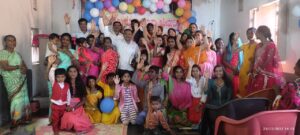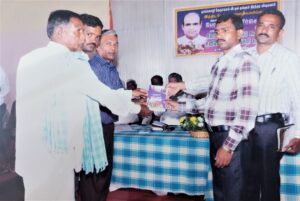LAMBANI Project
History of LAMBANI
The Lambani community is estimated to have a population of over 45 lakh (4.5 million) people in India. Lambanis, also called Lambadis or Banjaras, were nomadic tribes who came from Afghanistan to Rajasthan and have now spread themselves across Karnataka districts of Davangere, Ballari, Shivamogga, Dharwad, Gadag, Vijaynagar, Haveri, Koppala, Raichur, Bidar, Gulburga, Belgaum, Vijapur, Mandya, Tumkur, Hasan, Chikkaballapur, Doddaballapur, Hosadurga, Chikmagalur and the states of Andhra Pradesh, Telangana, Rajasthan, Madhya Pradesh, Gujarat and Maharashtra. In the 17th century, they are believed to have assisted the Mughal Emperor Aurangzeb in carrying goods to the southern part of India. Some of them settled there.
Food Habits of Lambani People:
They are known for their preference for spicy foods and a fondness for non-vegetarian dishes. Traditional staples include Bati (roti) and Daliya (a dish made from mixed cereals). Saloi, a non-vegetarian dish made from goat or sheep blood and intestines, is a popular Lambani speciality. Additionally, they consume Ghuggari (boiled red grams) and Patali Bati, a type of roti made from ragi or bajra.
Occupation of the Lambani People:
The Lambani community’s traditional occupations are agriculture, animal husbandry, salt trading, construction work, and selling forest produce. They are also known for their unique embroidery and other crafts, and some engage in petty business.
LAMBANI Culture
Social and Cultural Practices of the Lambani People:
The Lambani people believe in a number of gods and goddesses, and they hold many festivals and ceremonies throughout the year to honour them. They also have a strong oral tradition, passed down through generations, of storytelling, music and dance. The most recognisable aspects of Lambani culture are the vibrant and colourful clothing worn by the women. The traditional clothing includes a saree or ghaghra, a long skirt, and a blouse called “kapda”, and it is often adorned with intricate embroidery, mirror work and other embellishments. Traditional Lambani weddings are full of old customs, and it is held in villages or thandas with authentic rituals, folk songs, and simple feasts. The bride wears a hand-embroidered ghagra, and the community joins in dancing and drumming. Whereas in Modern Lambani weddings happen with new trends and modern culture.
Education and Christianity:
The literacy rate among this community in India is generally low compared to the national average. The Christian population of the Lambani tribe is 1.62%.
IBT Translation Ministry among the Lambani People
Rev. Prof. Panneer Selvam had a vision to give the Bible in the Lambani Language. He selected the Lambani translators, Mr. Parameshappa and Mr. Hanumanth, in 200,7 and they were given training in Bible Translation.
- The Gospel of Mark in the Lambani language was dedicated and released by IBT representative Mr. Samuel Gnanadhas on 02.06.2014 on the first Memorial Day of Late Rev. Prof. Panneer Selvam, Founder of IBT in Coimbatore, and distributed to the Lambani-speaking people.
- The New Testament in the Lambani language is proposed to be released in 2025. The page setting is in process.
- Financial support of Rs. 1,80,000/- is required to print 1000 copies, which costs Rs. 180/- per Bible approximately.

Indian Bible Translators
14 Ashok Layout,
Civil Aerodrome Road,
Coimbatore – 641 014
- 90470 57414
- 90470 57414
- 0422 - 4520123
- info@ibtword.com
- indianbibletranslators@gmail.com
- Privacy Policy
Donate now by scanning our UPI QR code
through your payment apps.

© Copyright IBT | Designed and Developed by Pixtornet


